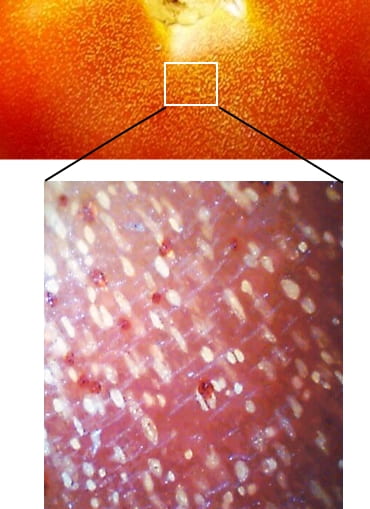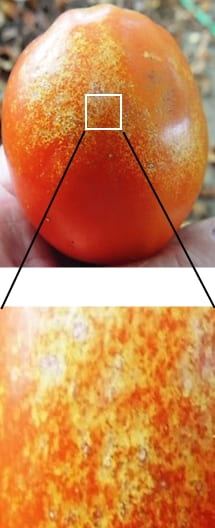Jerry Brust, IPM Vegetable Specialist, University of Maryland; jbrust@umd.edu
“Why do I still have gold fleck on my tomatoes when I have sprayed repeatedly for thrips? I must have a resistant thrips population.” I have heard growers tell me this a few times this year. When I ask why they think they have a thrips problem since they usually tell me they do not see any thrips it is because of the gold flecking (Figure 1) they see on their tomatoes at harvest. While gold fleck on tomatoes can be caused by a moderately high thrips population, at this time of year the explanation of the cause of flecking is more likely due to the weather conditions we have been having. I have conducted research and read many other studies on gold flecking over the last 5 years and they all point to 3 main possible causes. The most likely and common one is when we have high daytime (>88°F) and nighttime (>68°F) temperatures combined with high humidity (dew point temperatures >68°F) and that is what we are experiencing now and have been from July through August. The second most common cause is high populations of either two spotted spider mites (more common) or thrips (less common) feeding on the plant. You can tell that high populations are present when the mites or thrips feeding on the leaves cause white speckles (stippling) on the leaves of a plant (Figures 2 and 3). Sometimes the damage becomes so bad that the edge of a leaf will turn brown and die because of the feeding (Figure 4).
Figure 1. Gold flecking on a red round and a plum tomato
Gold flecking is not from direct mite or thrips feeding on the fruit itself—it can’t be because gold flecking can be induced in tomatoes with no thrips or mites being present with high temperatures and humidity. Mites and thrips CAN feed directly on tomato fruit and this damage can superficially look like gold flecking. But the actual ‘fleck’ in gold flecking is caused by calcium salt crystals that form inside a cell. Mites or thrips damage the fruit to get at the juices and leave damaged cells behind (Figure 4). If you rub you finger or thumb lightly over gold flecked fruit it will feel smooth, but rub it over thrips or mite damaged fruit and it feels rough. At times, if mite populations are high you could get both gold flecking and direct mite feeding on a single fruit. The third possibility that is pretty rare for field production tomatoes is excessive levels of calcium and phosphorous, but these levels have to be extremely high and rarely if ever occur under field conditions. They do occur, though, at times in hydroponic production systems where gold flecking is considered more of a nutrient imbalance. This is just a quick summary of the work that has been done on this very difficult-to-pin-down problem.
So if you have been spraying for thrips because of gold flecking and you are still seeing it, STOP SPRAYING and check for: 1. thrips, and 2. two-spotted spider mites. You might find a few of each of these, especially the mites as they like hot dry weather, exactly what we have been having. Also look at the foliage to see if there is white speckling over most of the middle and top half of the plant. If it is mites Oberon or Portal (both have a 1-day PHI) or Acramite (with a 3-day PHI) can be used. But chances are you have only low levels of either of these two pests and it is more likely because of our weather conditions that you continue to see gold flecking on your tomatoes.
Figure 2. Moderate white flecking on leaves caused by two spotted spider mite feeding.
Figure 3. Heavy feeding damage on tomato leaves caused by two spotted spider mite feeding
Figure 4. Very heavy TSSM feeding on tomato leaf
Figure 5. Comparison of gold flecking on the top and mite or thrips feeding on the bottom






